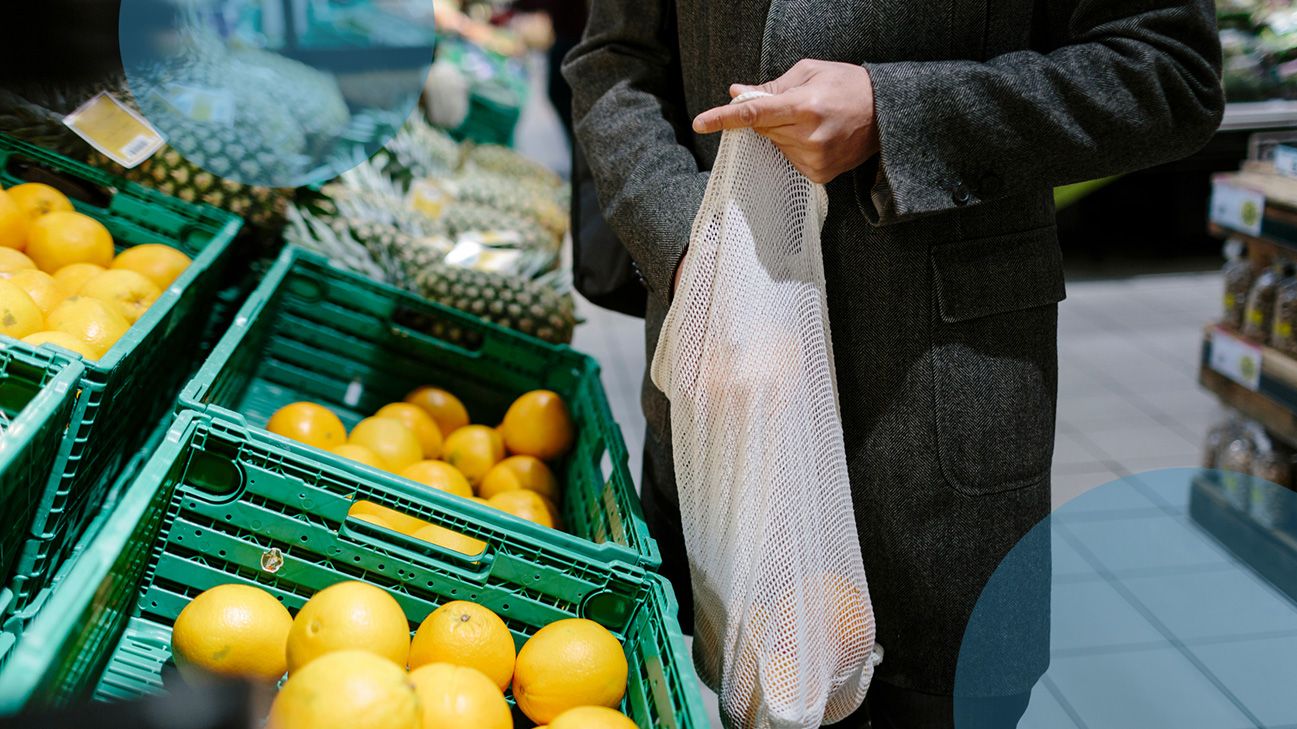This Is How I Grocery Shop for My Type 2 Diabetes
March 30, 2023
Content created for the Bezzy community and sponsored by our partners. Learn More

Photography by Jimena Roquero/Stocksy United
Walking into a grocery store after a type 2 diabetes diagnosis can be overwhelming. Here’s what I include on my shopping list to help you navigate the aisles.
When I was diagnosed with type 2 diabetes 20 years ago, the most challenging fact I needed to face was that I had to change my relationship with food. I’m a picky eater. I was raised on a farm and have always considered myself a “meat and potatoes” type of eater.
I didn’t start eating salads until college, and my favorite vegetables are corn, peas, and green beans. And potatoes. Of all kinds. I’m not fond of onions, broccoli, cauliflower, bok choy, or mushrooms. Did I mention I love potatoes?
Finding a balance between what I like to eat and what others recommend that I eat has been a struggle. But over time, my tastebuds have changed and maybe even matured. Slightly. Still, I’m not a fan of onions.


Find a meal plan that works for you
If you’ve recently been diagnosed with type 2 diabetes and feel overwhelmed by the new habits you need to incorporate into your life as you learn to live with a chronic health condition, you’re not alone. On some days, the struggle is real. On others, everything goes as it should.
Anything can trip up the best-laid plans, like oversleeping, having a sick child, or having a car that won’t start, all of which can result in skipped meals or grabbing something unhealthy from a fast-food place or the quickie mart.
We’ve all done it, and if you’ve had type 2 diabetes as long as I have, your first thought is usually, “That’s probably gonna raise my blood sugar.”
The key to success when you have type 2 diabetes is finding a meal plan that works for you and allows for times when things aren’t always going to go smoothly. I try to always have a snack with me, which can sometimes double as a meal if I need to grab something on the go and don’t want to skip a meal. Snacks are important for me to keep close by in case my glucose levels get too low.
What’s on my grocery list?
In the sections below, I’ve listed the foods I include on my shopping list for type 2 diabetes broken down by breakfast, lunch, and dinner, so you can easily find the foods that interest you to include on your own list. Plus, I’ve included a short list of snacks that I keep on hand when I need a quick pick-me-up.
Breakfast items
- Eggs: Eggs are packed with protein and only about 72 calories per 50 grams.
- Mini bagels: These are lower in calories than a full-size bagel but help satisfy my carb cravings.
- Low sodium bacon: I alternate between turkey and regular bacon.
- Grits: I make a breakfast bowl with grits, eggs, and lean bacon.
- Fresh fruit: I try to eat what’s in season but always have apples and bananas around.
- Oatmeal: Very filling, especially when adding fresh fruits.
- Cereal: I like raisin bran.
Lunch items
- Tuna: This makes for a great sandwich.
- Canned chicken: Makes a great sandwich, or you can use it in a salad.
- Sugar-free bread: I look for bread without added corn syrup that isn’t necessarily whole grain.
- Fresh fruits: Love apple slices.
- Individual bags of chips: Love the crunch.
- Peanut butter: Great on a sandwich or with fruit.
Dinner items
- Chicken: I eat a lot of chicken, sometimes grilled with veggies or lightly crusted with bread crumbs and baked in the oven.
- Fish: I cook fish in various ways.
- Ground meat: I grab lean proteins like turkey and chicken.
- Green beans: If I can’t get fresh beans, I opt for the low sodium version.
- Sweet and white potatoes: Eaten in various ways.
- Salad mixes: Add protein for a filling meal.
- Beans: If canned, look for low sodium options.
- Brown rice: I frequently make stir-fry and add chicken or other lean proteins.
Snacks
- Popcorn: I buy single-serving sizes.
- Fresh fruit: Fruit is packed with fiber.
- Crackers: Not the healthiest choice, but they have enough calories to satisfy your hunger.
- Sugar-free Jell-O: Topped with whipped cream, this is a great dessert.
- Cheese: I buy blocks of cheese and slice them into 1-inch chunks so they’re easy to grab for a quick snack.
- Chocolate: I buy individually-wrapped pieces. I prefer milk chocolate.
These foods are always on my shopping list and often depend on what’s on sale for the week.
Work with a nutritionist
If figuring out what foods to eat stresses you out, working with a registered dietitian or nutritionist may be beneficial. Many local hospitals and health clinics have programs for those of us with diabetes that offer cooking classes as well as helpful advice on eating better and getting more exercise.
While working with a nutritionist can be costly, many health insurance providers will cover the cost, and some even have special programs for members to help manage their conditions.
One of the most important things you can learn when working with a food expert is how to read the labels on foods you buy at the grocery store. Many processed foods contain hidden sugars and high fructose corn syrup and should be eaten sparingly. When I read food labels, I try to avoid most foods with ingredients ending with “ose,” a common name for hidden sugars.
The bottom line
What I include on my grocery list may be different than yours, and that’s fine. But the basic foundation of a healthier eating plan with type 2 diabetes is similar: Avoid processed foods, seek out whole and fresh foods, and read nutrition labels to avoid hidden sugars.
Consistency is the key when following a meal plan for type 2 diabetes. Find foods you enjoy, and prepare them in ways that are appetizing and satiating to you. By doing so, you can still enjoy the foods you love and be confident in knowing that what you’re doing now is helping to avoid complications in the future.
Medically reviewed on March 30, 2023
1 Source


Like the story? React, bookmark, or share below:
Have thoughts or suggestions about this article? Email us at article-feedback@bezzy.com.
About the author